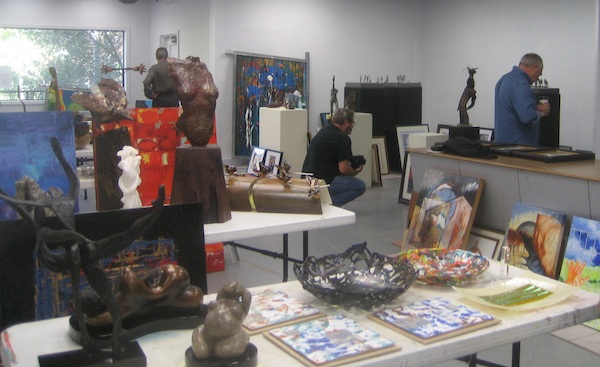Peggy's Progress
(Not to be confused with John Bunyan's tale of agony and doom!)

Time management experts, life coaches and self help writers have all told us about tackling overwhelming tasks and goals. In a former life when I managed large projects and a team of people I first read about the concept in Stephen Covey’s The 7 Habits of Highly Effective People . He characterized the process as “How to Eat An Elephant” by . He characterized the process as “How to Eat An Elephant” by
  what’s often referred to as “chunking” things down. My favorite variation on this theme, however, is depicted in this scene from the delightfully silly movie “What About Bob” starring a super neurotic Bill Murray as “Bob” and his new psychiatrist Dr. Leo Marvin played by Richard Dreyfus.
what’s often referred to as “chunking” things down. My favorite variation on this theme, however, is depicted in this scene from the delightfully silly movie “What About Bob” starring a super neurotic Bill Murray as “Bob” and his new psychiatrist Dr. Leo Marvin played by Richard Dreyfus.
Dr. Leo Marvin: Bob, there is a ground-breaking new book, that has just come out. Now, I have written this book . . “Baby Steps.”
Bob: Baby Steps?
Dr. Leo Marvin: It means setting small reasonable goals for yourself one day at a time. One tiny step at a time. For Instance, When you leave this office, don't think about everything you have to do in order to get out of the building just think of what you must do to get out of this room,and when you get to the hall, deal with that hall, and so ... You see? Baby steps!
Bob: (literally talking to himself) Baby steps, baby steps, baby steps through the office, baby steps out the door, it works! All I have to do is just take one little step at a time, and I can do anything! Baby step throughout the office, Baby steps onto the elevator, Baby steps into the elevator, I'm in the elevator, Ahhhhhhh!
And so I’m happy to report this month that I actually took a few “Baby Steps” of my own! In December I wrote about my “New Year’s resolution” to go on an Artist Date to explore the great
 outdoors, gather some plant materials to play with, and maybe create some sort of winter decoration. Not only did I get in the fresh air for a nice walk to gather bay leaves and alder cones and tassels but I made them into a wreath for the handmade gift required for the family holiday gift exchange. By stating my intentions here and saying it out loud to all of you in print I simply couldn’t face having absolutely no progress to report this time around. I needed that pressure to keep me from just flaking out and skipping the “date.”
outdoors, gather some plant materials to play with, and maybe create some sort of winter decoration. Not only did I get in the fresh air for a nice walk to gather bay leaves and alder cones and tassels but I made them into a wreath for the handmade gift required for the family holiday gift exchange. By stating my intentions here and saying it out loud to all of you in print I simply couldn’t face having absolutely no progress to report this time around. I needed that pressure to keep me from just flaking out and skipping the “date.”

The other good thing about saying things out loud and expressing intentions is that someone might actually hear you and respond in unexpected ways that support and further your own goals. By saying I wanted to play with concrete, my friend and one of our loyal readers, Leslie, said she too has always wanted to play with concrete. So now I’ve got a “concrete buddy” just like a “gym buddy” only much better as far as I’m concerned. Leslie and I have agreed to set a date when the weather is more conducive to playing outdoors with water and concrete. And although we haven’t set an exact date yet, we’re scheming to borrow a concrete mixer from another friend, and I’ve shared with her the concrete mix recipes that I’ve found for different types of projects in Sherri Warner Hunter’s books on concrete art.
Having a “concrete buddy” makes tackling something I’ve never tried before a lot less intimidating. And besides, Leslie is a lot of fun! And the added pressure that someone else is counting on me means I’ll actually have to follow through on it! Sounds like a winning proposition to me, so I expect to actually have some pieces to share with all of you before spring is over!
Rejected!
Let's talk for a minute about juried shows. Juried shows are one of the most perplexing and emotionally charged phenomena of the art world. We are involved in putting on a juried show right now for the Phantom Project, and today was intake day. This is one of those shows where everyone brings in their art in the morning and goes away for the lunch hour. The jurors make their choices, then everyone returns in the afternoon to see whether they made it into the show.

While this kind of show is very fast and efficient to jury, it is also the most traumatic for artists. If at least one of your pieces is accepted, you're spared the worst of the trauma. But if not, then your entire ego is laid bare, and you have to do what one artist at today's intake and jurying event good-naturedly called "the walk of shame." You can't just slink away to nurse your wounded ego, you have to pick up your work and walk it out the door for all to see.
The reaction of artists to this experience is as diverse as the artists to whom it happens. Some are devastated and find it difficult even to speak. Some shrug it off with little difficulty. Some are openly angry. Some are dignified and gracious. Some joke lightly. But no matter how good natured you are, no one likes being passed over by a juror.
Show curators often find euphemistic ways to refer to this, but to the artist it happens to, it always feels like rejection. It always tugs at your center and calls into question the very reason for your existence as an artist. And it's also the most ubiquitous experience that visual artists share. If you have not been juried out of a show, then you haven't entered enough shows. And if you are thin skinned about being juried out, you are pretty normal. Artists pour their soul into their work in ways that few other professions do. So it's tough to stand up and be civilized when somebody nonchalantly smacks down the expression of your deepest core.

Jurors at Work...
Add to this, the pure subjectivity of jurying art. Any three jurors will select different work for a show than any other three jurors. And often, the same juror will select different work on two different days. From the outside, the process might seem fickle and unfair. It might actually be fickle and unfair. Jurors are chosen for a show based on their expertise and experience in the art world. But the art world is purely subjective, as are the art, the artists, the jurors, the curators, the buyers, and the critics who contribute to this world. And yet we all respond to the reactions of a juror, a curator, or a critic, as if they had some final, authoritative, and objective dispensation on the merit of our work, our life, and our very soul. This reaction is absurd, of course, but almost inevitable.
At today's event, I saw frustration and disappointment on the faces of some very good artists over some very good art that was passed by. Some of these same artists have made it into some very good juried shows recently, and some of those selected today have been passed by recently as well. One of those artists just finished a solo show at one of the biggest, most important venues in the region just last week. She did not get in today.
I write about this to make a very important point. Rejection is the price of admission into this world of the full time artist. You will experience it. If you've been at it for long, you know this. If you've been at it for long, you've learned to steel yourself from it when it comes. If you have not experienced this sort of rejection, you have not entered enough juried shows. If your anger and frustration gets the best of you when the jurors pass over the work you have poured your heart and soul into, only to select an "obvious piece of crap" (and if you are for real as a working artist, they will eventually) then you are not entering enough juried shows. It's normal to feel anger, frustration, and self doubt at such times. Feel the feelings, but then get up and go again. Enter more juried shows! The art world expects it from you, and you cannot short cut your way around it. Paying your dues with juried shows is the venerable path in the art world. And it wouldn't be dues-paying if it always went your way. But you are the ultimate juror of your art. You have spent your self making your art. You have nourished your soul with making your art. A juror, by the necessity of the impossible task we assign to them spends seconds deciding to bless or ignore it. But jurors are here today, gone tomorrow. You are not. Stay the course. Keep getting up. Keep coming back. You will make your way.

Next Month's Interview
Next week, watch for our interview with Larry LeBrane, a remarkable glass and multimedia artist based in Los Osos, California. Larry spent 30 years teaching art in southern California before retiring to a full time art career. Larry's work is known throughout North America.
|



 outdoors, gather some plant materials to play with, and maybe create some sort of winter decoration. Not only did I get in the fresh air for a nice walk to gather bay leaves and alder cones and tassels but I made them into a wreath for the handmade gift required for the family holiday gift exchange. By stating my intentions here and saying it out loud to all of you in print I simply couldn’t face having absolutely no progress to report this time around. I needed that pressure to keep me from just flaking out and skipping the “date.”
outdoors, gather some plant materials to play with, and maybe create some sort of winter decoration. Not only did I get in the fresh air for a nice walk to gather bay leaves and alder cones and tassels but I made them into a wreath for the handmade gift required for the family holiday gift exchange. By stating my intentions here and saying it out loud to all of you in print I simply couldn’t face having absolutely no progress to report this time around. I needed that pressure to keep me from just flaking out and skipping the “date.”




